I have been out on the road doing some preliminary location shoots for my Masters dissertation, ‘Senghenydd’. Now, I am back and have analysed the results. I am hoping that most of this footage can be edited in some way or form into the final video. Being in South Wales on a visit, I had the time and opportunity to visit three sites to get some external footage. Even if it wasn’t used, it would give me a pointer towards what works, what doesn’t, and what extra bits were needed.
The plan was to visit the sites during daylight. The opportunity was created indirectly, as I had planned a week’s shoot in mid January. Big Pit, the coal mine museum at Blaenavon, was to be visited to get footage of the turning pit wheel (one of the few remaining examples). The wheel is under maintenance in January, so the opportunity to go earlier was taken. Whilst there, the thought came to visit the Senghenydd Community museum, to get some draft footage of the models of the valley and the colliery. With this in mind, I contacted both sites, to arrange permission to visit and shoot.
I also thought I would try and get some footage at the Rhondda Heritage Park, if I could – both external of the pit wheels and underground to get some sample stills for green screen. I did not contact them beforehand, as although situated 25 minutes from Senghenydd, I was not sure what time I could arrive there – so it was arrive on spec and anything gained would be a bonus. I have the 2 hour slot booked in January, to fall back on to get more detail underground and the last thing I want to do is get in people’s way, as they have been so helpful. The weather was glorious with azure skies, albeit windy, which was great for bright pictures of the sites, as long as I was not going for a broody, dark scene!
Senghenyss asked if I could come at 11, the opening time of their museum, so I planned out in advance time slots for my visit:
Big Pit – 9-10.30
Senghenydd – 11 – 12
Rhondda – 13- 15 (or basically whatever time I had left)
Then, a list of priority and ‘nice to have’ footage at each:
At Big Pit, I wanted the wheel turning and some images of the pit wheel with the valley and its houses in the background. The iconic picture for the valleys – a pit wheel with rows of terraces in the background, is so well illustrated at Blaenavon. What is a welcome addition is the bleak browns of the heather clad hills above. I took two shots of this, from different angles
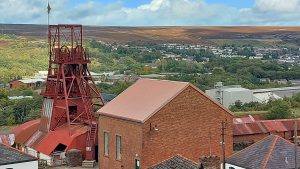
The ‘nice to have’ would have been shot in the cage and underground. However, Big Pit being an authentic mine setting, the area around the mine cage and below is ‘contraband free’ – meaning no naked flames or batteries are allowed, as coal mines always have a potential issue of methane gas being around, due to the nature of the mineral.
I had some issues with framing the wheel in the shot, to exclude the large Welsh flag that is flown from the structure. The flag is a useful thing to have in shots at the end of the movie – as a statement of identity. However, it was not the kind of thing present in the period that the drama is set. The first thing I noticed in the car park on arrival, was the glorious day created a wonderful harsh lit silhouette of the pithead. My camera of choice for the day was a camcorder, but I managed to get a great still from my Samsung A52 mobile.
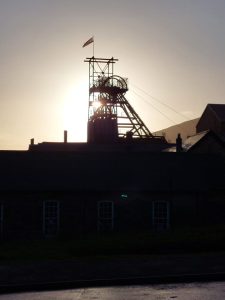
Unfortunately, the light was moving swiftly, so I did not have time to set up the camcorder and tripod and take a more leisurely shoot. My video of this on the mobile had some camera movement, the camcorder I have found, is worse at dealing with shakes.
So, I have driven 85 miles and only just got out of the car and already been dealt two lessons – to be open to opportunities as they present themselves and look at alternatives that may be usable – be flexible. I had originally expected to film using some serious kit from the dept., but the issue is on availability. (Also, the health and safety, risk assessments etc) The camcorder is a useful option, being tripod mounted and having a zoom option. However, I can get equally clear and possibly sharper images from my mobile, such is the technology of those beasts these days. So, lesson 2 – utilise what resources you have to hand.
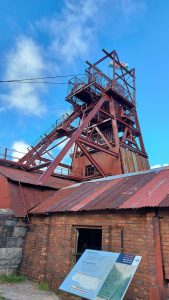
Lesson 3, roll with the punches. Having hiked up to a high point to get my panoramic shots, I moved down to outside the pithead. Another opportunity arose of a view of the pit wheel through a gap in the surrounding buildings.
Then I was faced with a huge problem. It was the world cup, Wales’ biggest game for 64 years was at 10am. As was the underground tour time that would set off the wheel turning. There was no way anyone would turn up for that tour – so the wheel wasn’t going to move before 10.45. I was due to be in my next venue at 11, it was 30 minutes away, once I had packed up etc… I might just have to make do with what shots I could get and come back at a later date for the wheel – or do without the shot. As it, was to be used to imply movement into the mine in the drama, this wasn’t desirable.
Another lesson learnt, be receptive to outside help. The men of the pit, having taken an interest in a stranger with a camera tripod standing patiently looking up were curious. When they found out my dilemma, they sent the cage down the shaft for me a few times anyway. I got my footage. I also learnt to be awake to potential background issues during this. Three things happened. A tourist walked directly past the camera (deliberately IMHO…) and the wind was feisty enough to tip the camera over at one point of the shot. These can be edited out, but can be avoided by identifying potential issues. The inexperienced cameraman in me, had decided things were going so well that I forgot to be alert to the danger.
Also, I noticed that Blaenavon is on the transatlantic flight path and vapour trails could be periodically seen in the sky above. Thankfully not when I was filming but always be aware of the background. (Charlton Heston was wearing a watch in the Ben Hur chariot scene, so it’s not just fledglings who get caught…)
Filming completed and very happy, I moved onto Senghenydd. The satnav took me over the mountain to drop into the Aber Valley, past a place I had earmarked for a shoot of the modern valley looking south. It was on a narrow twisting hilly road with passing places. The weather was kind, and I found one passing place was two car lengths, so I quickly decamped and took some footage. There were no other vehicles around, so not believing my luck, I wrapped and continued down to the museum.
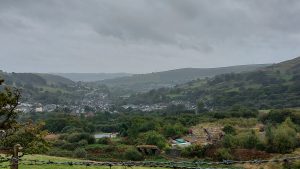
The museum is tucked away in the middle of Senghenydd and has wonderful displays of artifacts of the 1901 and 1913 disaster, together with info boards and films about the event. In particular, there are two models. One of the valley in 1913 and one of the colliery. Vital scenes for the start of my movie, as I draw people into the story by fading from the modern valley shot to the valley model, then the colliery model, then finally a modern day colliery itself (Lewis Merthyr). I took my shots, whilst Tracey, volunteer for the day, very kindly helped by adjusting the lighting and even providing illumination from her mobile at one point to help.
I noticed some figurines on display awarded to rescue workers in the pit. Also, there was a photo of the rescue team. these were useful for research. I won’t be able to be totally accurate in the film by recreating the equipment (the men are wearing deep sea diving helmets, for example). However, their carbide torches may be possible to use if I have issues with using a safety lamp on set. Never too late to learn about your subject… Notes for when I need to work on props.
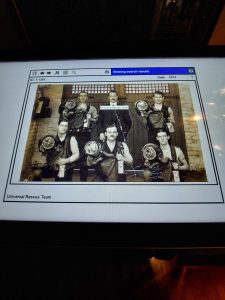
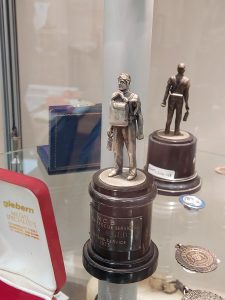
On my way out of town, I stopped at the memorial garden. It is a well maintained park on the site of Senghenydd colliery. The centre piece is a poignant statue, surrounded by walls that are tiled with the names of the men lost in the two explosions. A looped path nearby, is paved with the names of all colliery disasters in Wales. I took a few shots, walking the path, alongside the wall and to the statue. It made me think that my final postscript scene could be done as a voice over, not with an actor on site. (Less paperwork taking someone else away on Uni business too…) My footage was done with camcorder and then with mobile. The mobile footage was better, but all of it may have been too fast. I will redo that in January, but I do at least know what I can produce.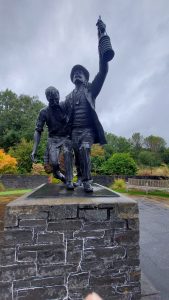
Tracey made me aware of an abandoned pithead at nearby Penallta, so I paid it a visit, as it was en route to my next venue. It was a huge twin pithead, but not the same set up as Senghenydd. I took some footage of the wheels, that may be of use. I also noted that all the wheels that do not work, have had their cables removed linking them to the wheelhouse. This may be only picked up by some of the audience, but worth bearing in mind when framing shots.
The final visit was to Trehafod, near Pontypridd, home of Lewis Merthyr pit, now the Rhondda Heritage Park. They were very, very kind (like everyone in the valleys to that point). No problem at all, to shoot outside, but no there were no tours running underground (It was Santa’s grotto for the duration!). As Mr Claus/Sion Corn did not feature in my work, I grasped the chance of some external shots. The day was still glorious – and the UK is a lottery with weather, so next time I may not have the weather so good. I took a few shots and ran a few videos for this vlog (did same at Big Pit), The result is below:
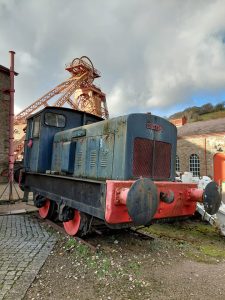
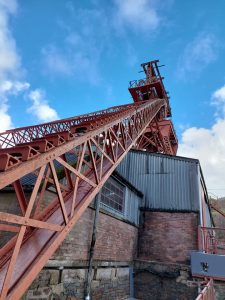
Having had a hugely successful day, I decided I had earned a very late lunch. The Heritage park has a superb recreated Italian cafe on site serving great food (Hot food and drink, such a blessing!) and custard slices the size of a seam of anthracite…
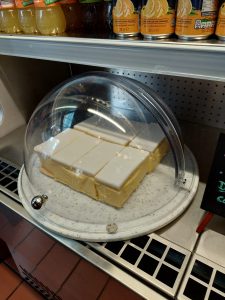
Then I earned me a chance to stop off at the legendary Grogg shop in Ponty. Well, it would have been rude not to…
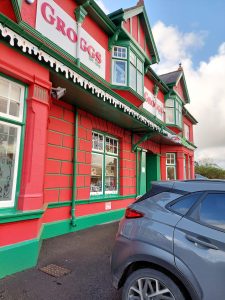
On return, I looked at my clips. The video was great, the sound was crap. I am lucky that these shots did not need accompanying live sound, as I will be over dubbing BBC sound effects, but a lesson again – check all your kit before you begin shooting. I put together a quick vlog during my day. One shows some footage at Big Pit and Rhondda side by side.
The other shows some simple post production editing – fading in and out of the start and end and a ‘Barn door’ transition between the two films. That’s just a quick idea of what you can do.
I was hoping to create the introduction to the film next, using all this footage. However, the editing suites are not available, so I need to use the time to put my pre-production and production paperwork into a form of legibility!
I am also starting work on a new history book on the Aberystwyth to Carmarthen railway and possibly further the novel ‘A light in the Darkness’ if I have time. In case you thought I wasn’t doing much else…